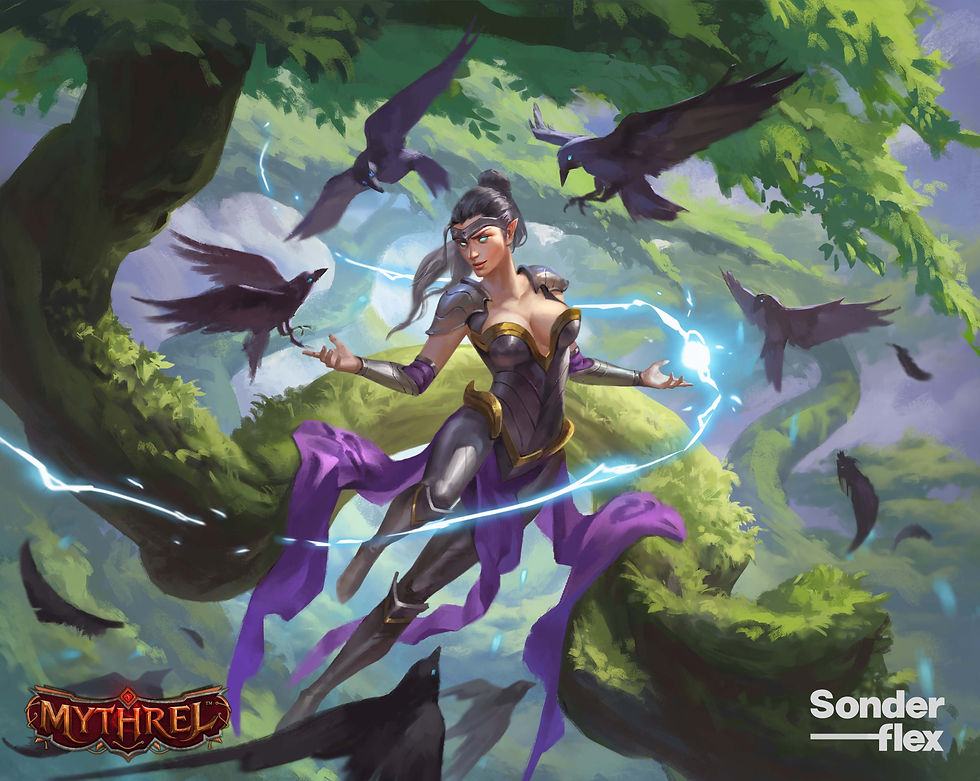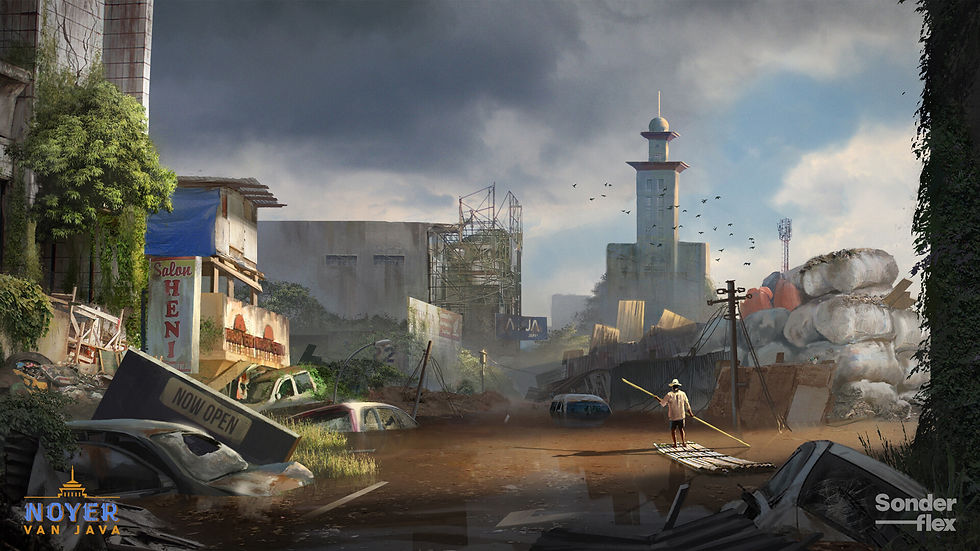Why Visual Identity Is Crucial for TCG Games Success
- Sonderflex Studio
- Jul 17
- 6 min read
Sonderflex Studio - In the fast-evolving world of trading card games, success rarely comes by accident. Developers invest months, if not years, into building compelling mechanics, balanced gameplay, and immersive narratives. Yet, amidst these design pillars lies one element that is often underestimated but fundamentally essential: visual identity. For any TCG to rise above the competition and create a lasting impression, it must offer a cohesive and compelling visual language that reinforces its brand and connects with its audience.
This article explores the critical role of visual identity in the success of TCG Games, analyzing how strong design direction can influence player engagement, brand loyalty, and market performance.

Defining Visual Identity in the Context of TCGs
Visual identity in TCG Games refers to the unified aesthetic presentation of the game. This includes card layouts, illustrations, typography, iconography, color palettes, and packaging design. It also encompasses broader applications such as the tone of promotional artwork, website interface, expansion branding, and merchandise visuals.
A strong visual identity helps establish a sense of familiarity and recognition. When players can instantly identify a card game by a character design, card border, or logo, the game has succeeded in building a visual identity that goes beyond function. This identity acts as a shorthand for everything the game represents, whether it is high fantasy, dark science fiction, or whimsical parody.
First Impressions and Shelf Presence

In a crowded market where hundreds of TCG titles compete for attention, first impressions matter more than ever. The vast majority of potential players first encounter a TCG through its visuals, whether on store shelves, crowdfunding platforms, or social media. If the art direction and branding do not immediately communicate quality and identity, the game risks being overlooked.
Packaging design plays a large part in this moment of discovery. A game’s box or booster pack should not only stand out from a visual standpoint but also convey its tone, complexity, and target audience. Consider how a minimalist box with elegant line work might suggest a strategic, refined game, while bold, explosive colors and stylized characters might appeal to action-focused audiences. Without words, visual identity tells the viewer what kind of world they are entering.
This principle extends to digital storefronts and online platforms. Games with strong visual identity are more likely to be clicked on, remembered, and shared. In many ways, great visuals serve as an invitation that says this game is worth your attention.
Building Emotional Connection Through Style

A powerful visual identity does more than attract attention. It helps players build an emotional connection with the game. The illustrations on the cards, the visual rhythm of the UI, and the storybook elements embedded in environments all contribute to how a player feels while playing.
Players form attachments to characters and factions not just because of gameplay mechanics, but because of how those elements are visualized. An elegantly rendered hero, a hauntingly detailed monster, or a uniquely designed card back can all stir feelings of admiration, nostalgia, or curiosity. These reactions deepen player investment and transform gameplay into something more personal.
Successful TCG Games use this connection to foster loyalty. When players love the visual language of a game, they are more likely to collect, share, and defend it. They become brand advocates, not because they were persuaded through marketing, but because they genuinely feel connected to the world the game has built.
Visual Consistency and Brand Recognition

A consistent visual identity across all touchpoints is essential for brand recognition. When every aspect of a game reflects a single unified style, the result is a polished, professional image that instills trust. On the other hand, inconsistent visuals can make a game feel amateurish or incoherent, even if the mechanics are strong.
Visual consistency ensures that expansion sets, spin-offs, and cross-media content reinforce the same core identity. Card backs should maintain recognizable design features. Logos should retain visual elements that link back to the original release. Characters should be drawn in the same stylistic vein, even if different artists contribute.
This kind of consistency allows TCG Games to build recognizable visual brands that players can follow over time. It also aids marketing efforts, since a game with a recognizable visual footprint stands out in conventions, trailers, and press features.
Competitive Advantage in a Crowded Market

The trading card game industry is more saturated than ever. With the resurgence of physical gaming post-pandemic and the growth of crowdfunding platforms, both indie and major publishers are releasing games at an unprecedented pace. In such a landscape, art can be the defining advantage.
Many games share similar mechanics or themes, but the visual identity can set them apart. A TCG might feature familiar gameplay elements such as deck building, resource management, or faction-based combat, but if its world is illustrated with breathtaking cohesion and style, it can capture attention where others fail.
This is especially true in the digital age, where images are scrolled through in seconds. A distinct art style becomes a game’s fingerprint. It encourages screenshots, fan art, and viral sharing. It makes the game recognizable on a YouTube thumbnail or a crowdfunding banner. In short, great visuals help games rise above the noise.
Case Study Comparison

Looking at the visual identities of top-performing TCG Games like Flesh and Blood, Sorcery Contested Realm, and Altered, one finds that visual excellence is never accidental. Each of these games invested deeply in a defined art direction that aligns with their gameplay and lore.
Flesh and Blood presents a polished fantasy world with painterly illustrations that echo classic trading card traditions. Its characters are dynamic and expressive, often placed in theatrical compositions that communicate power and story. Sorcery uses old-world aesthetics and surrealist compositions to emphasize its otherworldly themes. Its cards look like lost pages from forgotten manuscripts, instantly transporting players into a mythic setting. Altered embraces modernity with colorful, high-contrast illustrations and inventive character silhouettes that make its cards feel futuristic and refreshing.
These games have succeeded in part because their visuals were planned, deliberate, and fully integrated into the game experience.
Working With the Right Artists and Art Directors

To achieve visual excellence, developers must collaborate with the right artists. This process involves more than just hiring talent. It requires building a creative partnership where the artist understands the tone, target audience, and vision of the game. Without clear direction, even a skilled illustrator can produce work that feels out of sync with the brand.
Successful collaborations start with mood boards, references, and style guides. These tools ensure that everyone is aligned before production begins. During development, regular feedback loops allow artists and developers to refine the work while preserving its spirit. Ultimately, when an artist’s strengths align with the project’s needs, the result is visually powerful and emotionally resonant.
Publishers should also consider bringing on experienced art directors who can oversee visual cohesion. Art directors manage consistency, maintain tone, and ensure that multiple contributors deliver work that fits into a unified whole. Their presence can be the difference between a visually fractured release and a game that feels thoughtfully constructed from start to finish.
Art as Long-Term Value

Finally, visual identity contributes to the long-term value of TCG Games. In the secondary market, the most collected and treasured cards are often those with the most compelling artwork. Players will pay premiums for limited editions, alt-art variants, or first-print cards not because of their mechanics but because of their appearance.
Visual appeal also plays a major role in whether a game sustains itself over years or fades quickly. When a game’s visuals remain iconic, they continue to draw in new audiences long after release. Players who discover the game later are still drawn in by the art, and returning players feel a nostalgic pull toward a world they remember vividly. In essence, strong visual identity is not only a tool for launch but a foundation for legacy.
Conclusion

In the world of TCG Games, art is not just surface-level decoration. It is the language by which games communicate their tone, build community, and create lasting impressions. A strong visual identity draws attention, fosters emotional connection, maintains brand consistency, and delivers competitive advantage. It speaks to players before they ever draw their first hand or engage in their first duel.
Give Your Game Remastering Project a Visual Quality Upgrade with Sonderflex Studio's Expertise

Sonderflex Studio offers specialist visual design skills that are not only captivating but also effective. Game Remastering requires expertise able to deliver the same feeling and message as when the game was first played, yet looking twice as appealing.
Sonderflex Studio's visual design also considers the creative process with in-depth research into which remastered game values can and cannot be changed. Drop Sonderflex Studio a hello, and let's discuss further!



